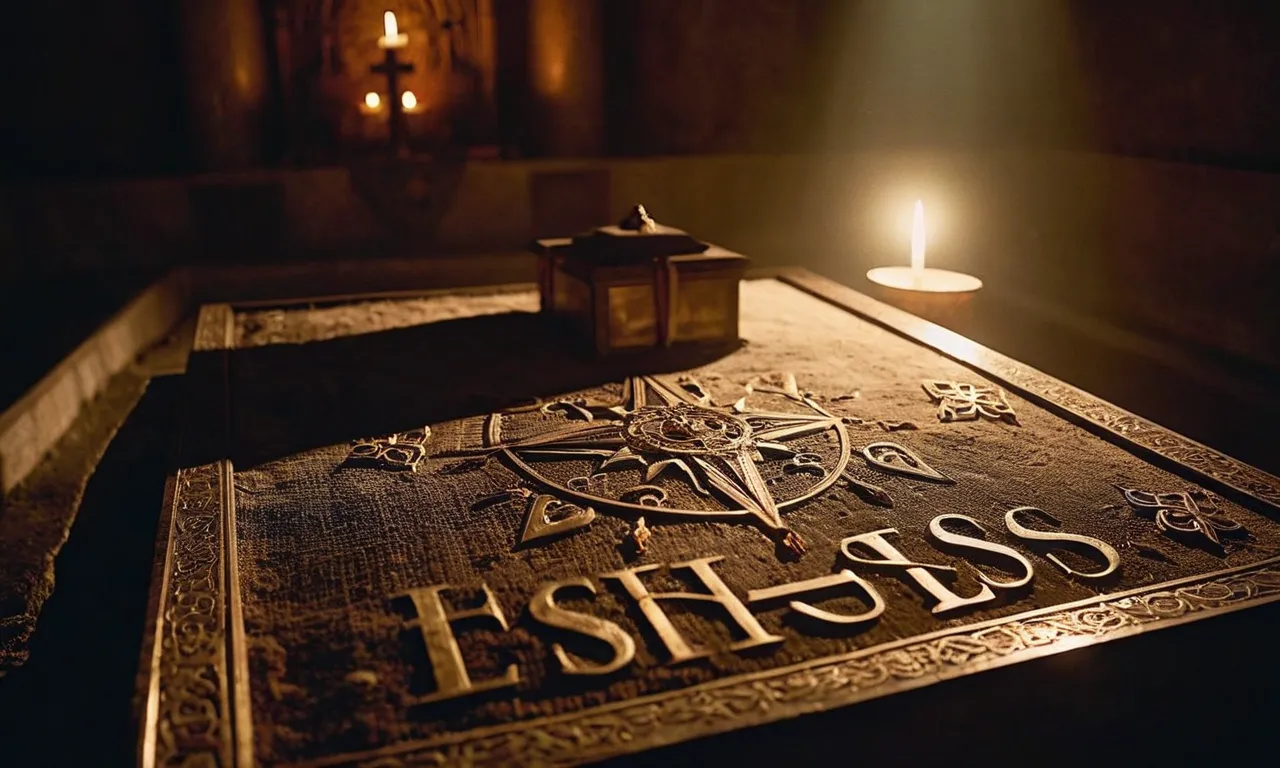Where Did Jesus Go When He Died For 3 Days? A Detailed Look At Christ’s Journey
The death and resurrection of Jesus Christ is central to the Christian faith. For three days after his crucifixion, Jesus’ body lay in the tomb while his spirit went on a mysterious journey.
Many have wondered: where exactly did Jesus go during those three days?
If you’re short on time, here’s a quick answer to your question: according to Scripture and Christian tradition, Jesus descended to the realm of the dead to preach salvation to imprisoned spirits before being resurrected on the third day.
Jesus’ Words About His Impending Death
Predictions of His Death and Resurrection
Jesus predicted his death and resurrection on several occasions during his ministry. Here are some key examples:
- After Peter declared that Jesus was the Christ, Jesus began to teach his disciples that he “must go to Jerusalem and suffer many things from the elders, chief priests and teachers of the law, and that he must be killed and on the third day be raised to life” (Matthew 16:21).
- As Jesus was going up to Jerusalem, he took the twelve disciples aside and said to them, “We are going up to Jerusalem, and the Son of Man will be delivered over to the chief priests and the teachers of the law.They will condemn him to death and will hand him over to the Gentiles to be mocked and flogged and crucified. On the third day he will be raised to life!” (Matthew 20:17-19)
- At the Last Supper, Jesus said, “This is my body given for you; do this in remembrance of me.” After the supper he said, “This cup is the new covenant in my blood, which is poured out for you” (Luke 22:19-20). These statements indicate he knew his death was imminent.
- After the Last Supper, Jesus predicted his betrayal by Judas and then said, “But after I have risen, I will go ahead of you into Galilee” (Matthew 26:32), indicating he knew he would rise again.
Jesus repeatedly told his disciples that he would suffer, die, and rise again on the third day. He made these predictions very clearly, so his disciples would expect his resurrection after his crucifixion. This gave them hope amid despair after his death.
His predictions also served to strengthen their faith when he did indeed rise from the dead, just as he said he would.
The Sign of Jonah
One key prophecy Jesus made about his death and resurrection is known as “the sign of Jonah.” Here is the account from Matthew 12:
- Then some of the Pharisees and teachers of the law said to him, “Teacher, we want to see a sign from you.” He answered, “A wicked and adulterous generation asks for a sign! But none will be given it except the sign of the prophet Jonah.For as Jonah was three days and three nights in the belly of a huge fish, so the Son of Man will be three days and three nights in the heart of the earth. “
Jesus was drawing a comparison between his upcoming death and resurrection and the experience of the Old Testament prophet Jonah.
Jonah spent 3 days in the belly of a great fish, and then the fish vomited him out onto dry land (Jonah 1:17). In the same way, Jesus predicted that he would spend three days in the grave before being resurrected.
The fact that Jesus specifically said it would be three days and three nights is important. This shows that Jesus knew the exact length of time he would spend in the tomb before being raised.
His resurrection on the third day was a precise fulfillment of this prophecy that displayed his foreknowledge and power over death.
Some key points about the sign of Jonah:
| – Jesus predicted the timing of his death and resurrection multiple times | – It proved Jesus has authority over death |
| – He knew he would spend three days in the tomb | – His resurrection on the third day fulfilled the sign of Jonah |
| – It gave hope to the disciples amid despair | – The precision of the timing strengthened faith in him |
Jesus purposefully and accurately predicted his death and resurrection, ensuring things happened according to God’s perfect timing and plan.
The sign of Jonah stands as an important prophecy that displays Jesus’ foreknowledge and sovereign power over death itself.

The Realm of the Dead in Scripture
Sheol/Hades in the Old Testament
The Old Testament refers to the realm of the dead as Sheol or Hades. This was believed to be the place where all souls went after death, both the righteous and unrighteous.
Sheol was portrayed as a shadowy and gloomy place where souls existed but didn’t experience any real life (Psalm 6:5, 88:10-12).
Though disembodied, people in Sheol maintained some form of identity and consciousness (Isaiah 14:9-11). Sheol was under the sovereignty of God (Amos 9:2), but cut off from His presence (Psalm 6:5).
The description and understanding of Sheol evolved in the Second Temple period. Later biblical texts started to suggest that Sheol/Hades was divided into two realms – a place of torment for the wicked and a paradise for the righteous (Luke 16:19-31).
This description of Sheol as having separate compartments prepared the way for the New Testament’s further revelation.
Christ’s Descent in the New Testament
According to the Apostles’ Creed, after His death on the cross, Jesus “descended into Hell.”
This statement comes from 1 Peter 3:19-20 which says, “After being made alive, he (Jesus) went and made proclamation to the imprisoned spirits – to those who were disobedient long ago.”
So in between His death and resurrection, Jesus visited the realm of the dead to proclaim His victory.
Some key things to know about Christ’s descent to the dead:
- Jesus did not suffer in hell or atone for sins. His atoning work was finished on the cross (John 19:30).
- He proclaimed triumph over evil powers and the redemption available through His death (Colossians 2:15, 1 Peter 3:18-22).
- His visit gave people there an opportunity to respond to the gospel. That’s why the creed says he “descended into hell” – preaching to spirits imprisoned (1 Peter 4:6).
- Jesus bridged the gap between paradise and torment, making salvation available to both (Ephesians 4:8-10).
So Christ’s journey to the underworld was to announce His victory and bring liberation to those waiting there, not to suffer further on our behalf.
Ancient Christian Views on Christ’s Descent
References in the Apostles’ Creed
The Apostles’ Creed, one of the oldest Christian creeds, makes a direct reference to Jesus’ descent into hell. Specifically, it states that after Jesus “was crucified, died, and was buried, he descended into hell.”
This line affirms the widely held belief in the early church that Jesus visited the realm of the dead after his death on the cross.
The Apostles’ Creed served as a baptismal confession in the early church, so Christians were professing their faith in Christ’s defeat of death and triumph over evil powers through his descent into hell. Jesus did not remain in hell but rose victorious on the third day.
The Purpose of Christ’s Descent
Victory Over Evil Forces
According to scripture, one purpose of Jesus’ brief time in the afterlife before His resurrection was to proclaim victory over evil spiritual forces and symbolically claim authority over them (1 Peter 3:18-20).
While exact details are scarce, many theologians believe Jesus boldly entered into the enemy’s camp to affirm His power and supremacy over darkness, fulfilling the prophecy of the Messiah’s absolute conquest.
Amazingly, in just three short days, Christ thoroughly dominated and disarmed the forces that had held humanity captive for eons (Colossians 2:15). His resurrection proved evil’s strongholds were crushed for good.
Preaching Salvation to Imprisoned Souls
Other key passages note that Jesus “preached to the spirits in prison” following His physical death (1 Peter 3:19-20). This cryptic reference likely points to His proclamation of the gospel’s power even to those who had already died.
The victorious Savior’s provision of eternal life extended past bodily limits, as He graciously made salvation’s free gift available even for those no longer living on earth.
Just imagine what explosive excitement spread through the gloomy darkness of the pit when the souls held captive there discovered that, at last, the long-awaited Messiah had secured their rescue too!
Alternative Theories About Christ’s Whereabouts
Soul Sleep
The “soul sleep” theory proposes that after Jesus died on the cross, His soul “slept” until the resurrection. This view suggests that the soul is unconscious between death and resurrection.
Some who hold this position cite verses like Ecclesiastes 9:5 which states that “the dead know nothing” and 1 Thessalonians 4:13-18 which refers to those who have died as “asleep.”
They suggest that the soul is inert during the interim period between death and resurrection.
However, other biblical scholars point out verses that seem to contradict this theory.
For example, Luke 23:43 records Jesus telling one of the criminals on the cross, “Today you will be with me in paradise.” This statement implies immediate consciousness after death.
Additionally, the story of Lazarus and the rich man in Luke 16:19-31 depicts the rich man being tormented in Hades while Lazarus is comforted in “Abraham’s bosom.” This passage portrays both men having awareness after death.
While there are various interpretations of this parable, it still challenges the notion of “soul sleep.”
So while some claim that Christ’s soul was inert for the three days between His crucifixion and resurrection, other biblical accounts seem to conflict with this perspective.
The full nature of His whereabouts during those three days continues to be debated among Bible scholars.
Paradise
One common belief is that when Jesus died, His spirit went to a place referred to as “paradise.” This view comes from Luke 23:43 where Jesus tells the thief on the cross, “Today you will be with me in paradise.” Paradise refers to a place of blessing and comfort in God’s presence.
Some associate paradise with heaven, while others distinguish it as another intermediate state.
In this perspective, paradise provided a place of rest for righteous souls before Jesus’ finished work on the cross granted them access to heaven (Hebrews 9:15).
This interpretation supports the possibility that before rising from the dead, Jesus’ spirit went to paradise rather than hell or heaven.
However, some challenge the notion that paradise remains a distinct place today. They cite verses like 2 Corinthians 12:4 where Paul refers to paradise in connection with the third heaven.
And in Revelation 2:7, the tree of life that was in Eden is said to be in paradise with God. These verses link paradise with heaven’s dwelling place with God.
So did Jesus spend the three days between His death and resurrection in a temporary paradise? Or did His spirit go directly to heaven?
Scholars debate these questions, but all Christians find hope in the resurrection – knowing that one day all believers will dwell with Him there eternally.
Conclusion
For three solemn yet mysterious days, Christ’s body lay in the tomb while his spirit descended into the realm of the dead. While details are scarce, Scripture and Christian tradition affirm that Jesus went to bring salvation to lost souls before rising again in power and glory.
The Descending Savior remains a central, awe-inspiring doctrine of the Christian faith.








